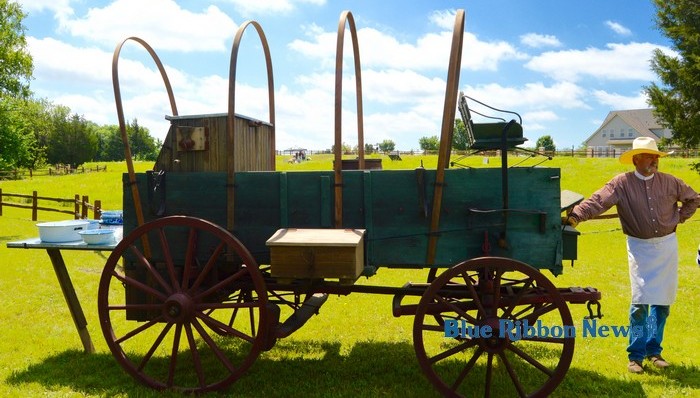(ROCKWALL, TX — May 24, 2016) History sprung to life this weekend at Harry Myers Park. Visitors of all ages got to see, touch, and even taste pioneer life at the Living History exhibit this Founder’s Day, presented by the Rockwall County Historical Foundation.
Historical Foundation Board Member Leigh Plagens said The Living History exhibit is an annual tradition that began as a way to encourage Rockwall citizens to reflect on the founding of the town and have some fun in the process. It is hosted at the Rockwall History House, the oldest structure in the county.
 “A lot of the Founder’s Day events have nothing to do with the founders,” Plagens said. “We wanted to take advantage of older stuff. We wanted to let people see what we have here at the museum.”
“A lot of the Founder’s Day events have nothing to do with the founders,” Plagens said. “We wanted to take advantage of older stuff. We wanted to let people see what we have here at the museum.”
This year, visitors could take a tour of the house and learn how to churn their own butter, (literally) spin yarns on the front porch, cook and eat food over a fire, and lease a title deed for farm land.
Kim Dills, who greeted guests on the front porch as soon as they arrived, has been spinning wool into yarn and thread since 1993. At the Living History exhibit, she showed visitors how to use an old fashioned spinning wheel to transform a basket of wool into a few feet of thread.
“This is my hobby, and I really enjoy doing it,” Dills said. “Today’s modern technology can spin a couple of miles in just a couple of minutes. I spin about an ounce an hour.”
Once inside the History House, guests were led into each room by Museum Curator Carolyn Holt. Holt explained that the house was built in 1850 with additional rooms added in 1880. Each room is covered in artifacts from the original families who lived there and from other aspects of Rockwall history.
 In the kitchen, Rockwall High School juniors Gretchen Reidling and Caitlyn Wilson taught guests how to churn milk into butter while clad in 19th-century bonnets. Wilson said she most enjoyed working with little kids as they visited the museum, and Reidling said the experience gave her a new perspective on history.
In the kitchen, Rockwall High School juniors Gretchen Reidling and Caitlyn Wilson taught guests how to churn milk into butter while clad in 19th-century bonnets. Wilson said she most enjoyed working with little kids as they visited the museum, and Reidling said the experience gave her a new perspective on history.
“Our student council teacher brought up this opportunity, and we said we would love to volunteer,” Reidling said. “It has been so cool to hear so many old stories. We grew up in Rockwall and everything has been so easy for us, but looking around and thinking about all of the things that people had to put more effort into has been so crazy.”
Just outside the house rested a chuck wagon and a fire pit where guests could chow down on beans and peach cobbler fresh from a cast iron pan.
In a field adjacent to the house, junior cotton farmers could lease a title deed to a small plot of land for $1. Each child who purchased a square yard of land was given his or her own folder containing a mock title document for Rockwall County, a map with directions to the cotton field indicating which plot they leased, a newsletter about growing cotton, and a Rockwall history-themed coloring book. The cotton patch will remain for the rest of the summer, and the kids are responsible for tending to their own crops. At the end of the summer, they can pick the cotton they’ve grown.
 Historical Foundation Board Member Jan Self said the cotton farming idea was a new addition to the exhibit this year that teaches kids about history, agriculture and responsibility.
Historical Foundation Board Member Jan Self said the cotton farming idea was a new addition to the exhibit this year that teaches kids about history, agriculture and responsibility.
“This is our first year, so it is an experiment,” Self said. “They are responsible for weeding and watering their own cotton plants. The first few weeks are most important to the cotton plant, so as long as they get water then, they are usually fine for the rest of the season.”
Self said previously each board member took care of one section of the cotton patch. It was her fellow board member Leslie Barrett’s idea to include kids in the farming fun.
“She’s the gal who thought up the grand idea of leasing plots for the purpose of community awareness, history of Rockwall’s cotton as ‘the’ crop back in the day, education of course, and to help us get the job done,” Self said. “Leslie went to great lengths to make every document in the lessor’s packet historically accurate.”
 Beside the History House rested a large collection of sandy stones arranged in a careful pattern on the ground. Plagens said these are stones excavated from the original rock wall, the city’s namesake. After The History Channel visited and uncovered the ancient wall back in 2013, a few of the stones were donated to the Rockwall County Historical Foundation. They were rearranged in their original pattern once they were transported to the History House, so that guests can imagine how they would have looked to the first settlers. Plagens said eventually they will be rebuilt into a free standing wall.
Beside the History House rested a large collection of sandy stones arranged in a careful pattern on the ground. Plagens said these are stones excavated from the original rock wall, the city’s namesake. After The History Channel visited and uncovered the ancient wall back in 2013, a few of the stones were donated to the Rockwall County Historical Foundation. They were rearranged in their original pattern once they were transported to the History House, so that guests can imagine how they would have looked to the first settlers. Plagens said eventually they will be rebuilt into a free standing wall.
Plagens hopes that by this time next year, visitors to the Living History Exhibit can fully experience this chapter of history that was buried underground for centuries.
Story by Blue Ribbon News reporter Julie Anne White. Photos by Blue Ribbon News student intern/photographer/videographer Blake Macaluso.
 Your #1 source for positive hometown stories, entertainment and events.
Your #1 source for positive hometown stories, entertainment and events.
Our print edition is delivered free to 18,000+ homes in Rockwall and Heath, TX.
To share your good news and events, email editor@BlueRibbonNews.com.
For advertising inquiries both online and in print, call 214-342-8000 or email advertising@BlueRibbonNews.com.
Download the FREE Official Rockwall Area App for Apple iPhone or Android.








